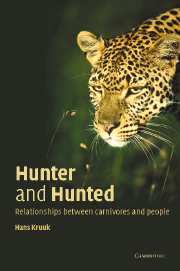Book contents
- Frontmatter
- Contents
- Preface
- 1 Turning the other cheek
- 2 Carnivore society: hermits and communes
- 3 The quarry of the hunter
- 4 Man the hunted
- 5 Competitors and carriers
- 6 History of a conflict
- 7 What is the use?
- 8 Wolves with human souls: pets
- 9 Carnivores and neighbours: effects on prey
- 10 Crying wolf: anti-predator behaviour
- 11 Carnivores in culture
- 12 The future
- Epilogue
- References
- Index
1 - Turning the other cheek
Published online by Cambridge University Press: 08 January 2010
- Frontmatter
- Contents
- Preface
- 1 Turning the other cheek
- 2 Carnivore society: hermits and communes
- 3 The quarry of the hunter
- 4 Man the hunted
- 5 Competitors and carriers
- 6 History of a conflict
- 7 What is the use?
- 8 Wolves with human souls: pets
- 9 Carnivores and neighbours: effects on prey
- 10 Crying wolf: anti-predator behaviour
- 11 Carnivores in culture
- 12 The future
- Epilogue
- References
- Index
Summary
CONUNDRUM
This is a story about competition, about predation, and about fear and attraction and beauty. It is the tale of our relationship with carnivores, both wild and tame, as hunters and pets, killers and scavengers. The book is about our own behaviour as well as about theirs. I will be discussing the ramifications of a simple question: why do we like carnivores so much, and why are we so totally fascinated by animals that are designed to be our enemies?
An early morning breaks over the huge, open grassland plain of the Serengeti, in East Africa. I am driving well away from any road, and my world is a vast expanse even beyond the horizon. The earth is just beginning to breathe in the sunlight, and small birds are stirring. Black dots appear ahead of me, some turning into ostriches, some into wildebeest. I stop, and I listen to the soft and distant grunts from the herd. It is a scene of total peace and expectation.
Beyond the wildebeest something stirs. Gazelles are running, and the wildebeest stop grunting. Lithe sinuous forms appear from the distance, a pack of sixteen African wild dogs, silent and fast. They create chaos all around them, and the wildebeest wheel and flee, bunching up with whisking tails. The dogs are criss-crossing in the turmoil.
One wildebeest cow separates from the herd, with her a calf next to her like a small motorcycle sidecar, both going as fast as their legs can carry them.
- Type
- Chapter
- Information
- Hunter and HuntedRelationships between Carnivores and People, pp. 1 - 20Publisher: Cambridge University PressPrint publication year: 2002



